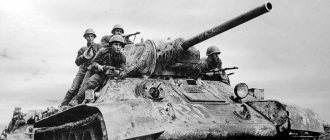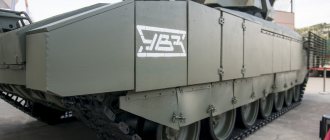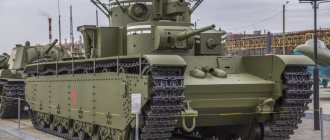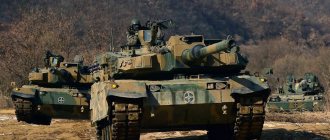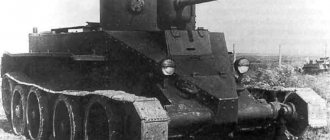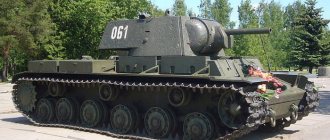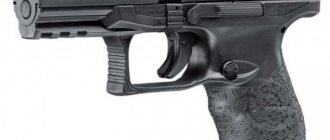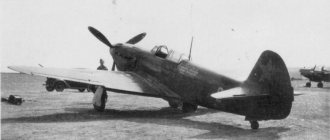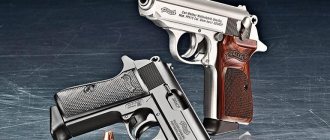The Soviet light combat vehicle, used in many conflicts of the 1930s and the Second World War, was designated T-26. This tank was produced in greater quantities (more than 11,000 units) than any other of that period. In 1930, the USSR developed 53 variants of the T-26, including a flamethrower tank, a combat engineering vehicle, a remote-controlled tank, a self-propelled gun, an artillery tractor and an armored personnel carrier. Twenty-three of them were mass-produced, the rest were experimental models.
British original
The T-26 had a prototype - the English Mk-E tank, which was developed in 1928-1929. Simple and easy to maintain, it was intended for export to less technologically developed countries: the USSR, Poland, Argentina, Brazil, Japan, Thailand, China and many others. Vickers advertised its tank in military publications, and the Soviet Union expressed interest in this development. According to the contract signed on May 28, 1930, the company supplied to the USSR 15 double-turreted vehicles (type A, armed with two 7.71 mm Vickers machine guns, water-cooled) along with complete technical documentation for their mass production. Having two turrets that could rotate independently made it possible to fire both left and right simultaneously, which was considered an advantage for breaking through field fortifications at the time. Several Soviet engineers participated in the assembly of tanks in 1930. Before the end of this year, the first four Mk-E type A arrived in the USSR.
Start of mass production
At that time, a special commission was working in the USSR, whose task was to select a foreign tank for replication. The English tank Mk-E received the temporary designation B-26 in its documentation. In the winter of 1930-1931, two such machines were tested at a training ground in the Poklonnaya Gora area, which they successfully passed. As a result, already in February it was decided to begin their production in the USSR under the designation T-26.
The tank from the first experimental batch, equipped with Soviet-made turrets, was tested for resistance to rifle and machine gun fire in the late summer of 1931. It was fired from a rifle and a Maxim machine gun using conventional and armor-piercing cartridges from a distance of 50 m. It was found that the tank withstood the fire with minimal damage (only some rivets were damaged). Chemical analysis showed that the front armor plates were made of high-grade armor, while the roof and lower turret plates were made of ordinary steel. At that time, the armor produced by the Izhora plant, used for the first T-26 models, was inferior in quality to the English one due to the lack of modern metallurgical equipment in the USSR.
Development of the first modifications in 1931
Soviet engineers did not just repeat the 6-ton Vickers. What new did they bring to the T-26? The tank in 1931, like its British prototype, had a double-turret configuration with two machine guns, one on each turret. The main difference between them was that on the T-26 the turrets were higher, with viewing slits. The Soviet turrets had a circular embrasure for the Degtyarev tank machine gun, as opposed to the rectangular one used in the original British design for the Vickers machine gun. The front of the hull has also been slightly modified.
The hulls of the T-26s with two turrets were assembled using 13-15 mm armor plates riveted to a frame made of metal angles. This was enough to withstand machine gun fire. Light tanks of the USSR, produced at the end of 1932-1933, had both riveted and welded hulls. The same cannot be said about the new product. The Soviet T-26 tank, developed in 1931, had two cylindrical turrets mounted on ball bearings; each of the towers rotated independently by 240°. Both towers could provide fire in the front and rear firing arcs (100° each). What was the main drawback of the T-26 tank? The two-turret version had an overly complex design, which reduced its reliability. In addition, all the firepower of such a tank could not be used on one side. Therefore, in the early 30s, this configuration of combat vehicles was abandoned all over the world.
Single-turret light tank T-26
Its characteristics were significantly improved compared to the two-turret configuration. Produced since 1933, it initially had a cylindrical turret with one Model 20K cannon of 45 mm caliber and one Degtyarev machine gun of 7.62 mm caliber. This gun was an improved copy of the Model 19K anti-tank gun (1932), which was one of the most powerful of its time. Very few, if any, tanks from other countries had similar guns. What other weapons was the new T-26 capable of carrying? The 1933 tank could have up to three additional 7.62 mm machine guns. This increase in firepower was intended to assist crews in defeating special anti-tank teams, as the original machine gun armament was found to be insufficient. The photo below shows one of the T-26 models, which is located at the Kubinka Tank Museum, which is the world's largest collection of military vehicles.
Next, let's talk about the technical characteristics.
TTX T-26 model 1933
basic information
- Classification - light infantry tank;
- Combat weight - 8 tons;
- Crew – 3 people;
- Years of production – 1931-1941;
- Years of operation: 1931-1960;
- Number of units produced: 11,218 pieces.
Dimensions
- Case length – 4620 mm;
- Case width – 2440 mm;
- Height – 2190 mm;
- Ground clearance – 380 mm.
Booking
- Armor type - rolled homogeneous steel;
- Body forehead – 15 mm;
- Body side – 15 mm;
- Hull stern – 15 mm;
- Bottom – 6 mm;
- Housing roof – 10 mm;
- Turret forehead – 15 mm;
- Gun mantlet – 15 mm;
- Turret side – 15 mm;
- Turret feed – 15 mm;
- Tower roof – 6 mm.
Armament
- Caliber and brand of gun - 45 mm 20K;
- Barrel length - 46 calibers;
- Ammunition - 203 shells;
- Machine guns - 2 × 7.62 mm DT.
Mobility
- Engine type - in-line 4-cylinder carburetor air-cooled;
- Engine power – 90-91 hp;
- Highway speed – 30 km/h;
- Cruising range on the highway – 120 km;
- Suspension type: four-blocked, with leaf springs;
- Climbability - 40°;
- The wall to be overcome is 0.75 m;
- The ditch to be overcome is 2.0 m;
- The fordability is 0.8 m.
What engine did the T-26 tank have?
Its characteristics, unfortunately, were determined by the level of engine manufacturing back in the 20s of the 20th century. The tank was equipped with a 4-cylinder gasoline engine producing 90 hp. With. (67 kW) air-cooled, which was a complete copy of the Armstrong-Sidley engine used in the 6-ton Vickers. It was located at the rear of the tank. Early Soviet-made tank engines were of poor quality, but this improved from 1934 onwards. The engine of the T-26 tank did not have a speed limiter, which often led to overheating and damage to its valves, especially in the summer. A 182 L fuel tank and a 27 L oil tank were located next to the engine. He used high-octane, so-called Grozny gasoline; refueling with second-grade fuel could damage the valves due to its detonation. Subsequently, a larger fuel tank was introduced (290 l instead of 182 l). The engine cooling fan was installed above it in a special casing.
The T-26's transmission consisted of a single-plate dry clutch main clutch, a five-gear box at the front of the tank, steering clutches, final drives, and a brake group. The gearbox was connected to the engine via a drive shaft running along the tank. The gear shift lever was installed directly on the box.
IRON
The first sign of the Far Easterners was an armored personnel carrier based on the T-26. The car turned out to be quite good, but overweight; with a full load, driving in top gear could only happen on a good road; the slightest rise required a shift to a lower gear. It was impossible to use the car as an artillery tractor. After release 400 pcs. production of armored personnel carriers was stopped. Instead, an artillery tractor was put on the conveyor, inheriting the technical solutions of the armored personnel carrier, but weighing only 8 tons and on a standard tank chassis. The resulting tractor was capable of transporting a gun crew, half a ton of ammunition, and towing trailers weighing up to 1.5 tons on the ground.
The demand for the new vehicle was enormous; artillery units literally bombarded the GABTU with requests for tractors. Because of this, the bulk of the T-26 tanks began to be converted into a medium artillery tractor (SAT). During the period before 1945, more than a thousand tractors were manufactured. By 1943, the production of tractors was faced with the problem of a lack of chassis parts. Intensive training of tank crews in Far Eastern schools led to a shortage of tracks and road wheels. A solution was found in using parts and tracks from the T-70 light tank (since 1944 from the SU-76). Torsion bars were mounted under the bottom, and drive wheels were also used.
Reducing the drive wheel slightly reduced the maximum speed on the highway, but overall did not affect the mobility and reliability of the car. Further combat use showed the uselessness of a machine gun turret on an artillery tractor. Occasional use did not justify the extra weight and labor costs. At the end of 1943, the tractor was redesigned. The turret with the machine gun was removed, the commander's seat was placed next to the driver or removed altogether, making the tractor a single-seat universal chassis.
The chassis could be equipped with various equipment, turned into a fuel tanker, ammunition transporter, repair vehicle, etc. Intensive experiments were carried out on the installation of various weapons. Thus, at the end of 1944, a 100-mm BS-3 field gun was installed on the chassis.
The success of the SAT pushed the developers to solve the problem of towing the main artillery of the Red Army - the 122-mm M-30 howitzer. The existing tractor could not pull a 2.5-ton howitzer; the 90-horsepower engine was clearly not enough. But there was nowhere to get another one, attempts to boost the engine ended in failure, the increase in power sharply reduced the resource. Then it was decided to radically reduce the weight of the tractor, cutting off everything that was possible.
Despite the strange appearance, the vehicle showed good maneuverability and a large traction force on the hook. Now the howitzer could be towed by the new vehicle along a dirt road in top gear.
In 1943, the tractor also received a new chassis from the T-70 and a new two-seater cabin. Part of the crew (4 people) could be placed on an open bench in the rear of the tractor. About 800 pieces were produced.
Modernization 1938-1939
This year, the Soviet T-26 tank received a new conical turret with better resistance to bullets, but it still had the same welded hull as the 1933 model. This was not enough, as the conflict with the Japanese militarists in 1938 showed, so the tank was modernized again in February 1939. Now he received a turret compartment with inclined (23°) 20-mm side armored plates. The thickness of the tower walls increased to 20 mm with a tilt of 18 degrees. This tank was designated T-26-1 (known as the T-26 Model 1939 in modern sources). Subsequent attempts to strengthen the front panel remained unrealized, as production of the T-26 soon ceased in favor of other designs such as the T-34.
By the way, the combat weight of T-26 tanks in the period from 1931 to 1939 increased from 8 to 10.25 tons. The photo below shows the T-26 model 1939. By the way, it is also from the collection owned by the world's largest Tank Museum in Kubinka.
Tank in culture
The T-26 tank is widely represented in various computer games, such as:
- "Blitzkrieg";
- "Sudden Strike"
- "Steel Panthers"
- "Flashpoint: Resistance", in the modification "Liberation 1941-45";
- "The Second World War";
- "Behind Enemy Lines"
- Multiplayer games "World of Tanks" and "War Thunder".
Often the performance characteristics of tanks in games do not correspond to real ones.
To the cinema
Authentic T-26s can be seen in the film Tankers (1939, USSR).
Memory of a tank
The T-26 tank is widely represented in various museums around the world, for example, in:
- Bovington Tank Museum;
- Museum of the breakthrough of the siege of Leningrad (model 1933);
- Finland in the barracks in the Karkialampi area;
- Military History Museum of Lenino-Snegiri (model 1933);
- Moscow Museum of the Great Patriotic War (model 1931);
- Tank Museum Parola;
- Kubinka Museum;
There are also several T-26 monuments. One of them was installed in Pitkäranta as a monument “Glory to the Heroes”. Local historians claim that this T-26 took part in the Soviet-Finnish war and was raised from the bottom of Lake Ladoga in 1998.
Another T-26 is standing in Vybor near the first house on Pobeda Street. He also took part in the Soviet-Finnish war, and he was also raised from the bottom - but not of Lake Ladoga, but of the Gulf of Finland.
More material on the topic
- M4 Sherman
- New deadly tank T90MS
How the combat history of the T-26 began
The T-26 light tank first saw action during the Spanish Civil War. Then the Soviet Union, starting in October 1936, supplied its republican government with a total of 281 tanks of the 1933 model.
The first batch of tanks to Republican Spain was delivered on October 13, 1936 to the port city of Cartagena; fifty T-26s with spare parts, ammunition, fuel and about 80 volunteers under the command of the commander of the 8th separate mechanized brigade, Colonel S. Krivoshein.
The first Soviet vehicles delivered to Cartagena were intended to train republican tank crews, but the situation around Madrid became more difficult, so the first fifteen tanks were consolidated into a tank company, the command of which was taken by the Soviet captain Paul Armand (Latvian by birth, but raised in France) .
Arman's company entered the battle on October 29, 1936, 30 km southwest of Madrid. Twelve T-26s advanced 35 km during a ten-hour raid and inflicted significant losses on the Francoists (about two squadrons of Moroccan cavalry and two infantry battalions were defeated; twelve 75-mm field guns, four CV-33 tankettes and from twenty to thirty trucks with military cargo were destroyed or damaged) with the loss of three T-26s from gasoline bombs and artillery fire.
The first known case of ramming in tank warfare occurred on the day when the tank of platoon commander Lieutenant Semyon Osadchy collided with two Italian CV-33 wedges, throwing one of them into a small gorge. The crew members of the other wedge were killed by machine gun fire.
Captain Arman's car was burned by a gasoline bomb, but the wounded commander continued to lead the company. His tank destroyed one and damaged two CV-33 tankettes with cannon fire. On December 31, 1936, Captain P. Arman received the Star of the Hero of the USSR for this raid and active participation in the defense of Madrid. On November 17, 1936, Arman's company had only five tanks in combat-ready condition.
The T-26s were used in almost every military operation of the Civil War and demonstrated superiority over the German Panzer division of light tanks and the Italian CV-33 tankettes armed only with machine guns. During the Battle of Guadalajara, the superiority of the T-26 was so obvious that Italian designers were inspired to develop a similar first Italian medium tank, the Fiat M13/40.
T-26: the most popular pre-war Soviet tank
How the Soviet Union received an armored vehicle that took part in all the wars of the 1930s and 40s
This tank, along with the tanks of the BT family, was the basis of the armored forces of the Red Army on the eve of the Great Patriotic War and fought until the very end of the war. It was on this tank that the world's first tank ram was carried out, and the tanker who was the first to receive the title of Hero of the Soviet Union also fought on it. It went through all the local conflicts of the second half of the thirties of the twentieth century, in which the Soviet Union participated in one way or another, and became one of the most recognizable symbols of the country. This tank, the T-26, is a machine that helped the Red Army raise more than one generation of tankers who became famous during the Great Patriotic War.
An Englishman who became a Russian
Despite the fact that after the creation of the T-18 tank (aka MS-1), the Soviet Union became one of the largest tank-building powers, it has not yet received a serious school for designing armored vehicles. The successes of Soviet engineers were rather a successful redesign of tanks that had already proven themselves on the fields of the First World War, and the country needed more modern models. The solution was found in the traditional approach of that time: to acquire foreign developments and begin their licensed production, in the process of which future Soviet tank designers would begin to learn.
In order to select the most suitable tank models and agree on their purchase, a special purchasing commission was created headed by the head of the Department of Motorization and Mechanization of the Red Army, Innokenty Khalepsky, and tank engineer Semyon Ginzburg. The commission was to visit several countries - Germany, Italy, Great Britain, Czechoslovakia, France and the USA. It was as a result of this trip that the tanks that became the basis were purchased: for the future T-26 - the British Vickers 6 tons, and for the BT-2 - the American Christie.
Britain at that time was considered the main trendsetter in tank fashion, and several samples of armored vehicles were selected from British factories. The six-ton Vickers was of greatest interest: it perfectly met the requirements that the Red Army had for a light tank, or, as they were called then, an infantry escort tank. In addition, members of the procurement commission knew that these same tanks aroused interest among other states, including Poland, which was considered the main potential enemy of the USSR in those years. So the contract for the purchase of 15 Vickers 6 tons and documentation for licensed production was signed quite quickly, and already in October 1930, the first of the purchased tanks arrived in the Soviet Union.
When one head is better than two
Of the two options for the British vehicle - a double-turret with two machine guns and a single-turret with a cannon and a machine gun - the purchasing committee chose the one with two turrets. Such a tank better met the requirements for an infantry escort vehicle, since it was actually a mobile firing point capable of conducting all-round fire. Much later, when the T-26 had already received its baptism of fire, it became clear that the two-turreted vehicle had another advantage: it could be used to clear enemy trenches. It was enough to stop the tank across the trench, and two machine guns began to fire along it, literally mowing down enemy soldiers.
Adapting the six-ton Vickers to domestic production, Soviet engineers under the leadership of Semyon Ginzburg slightly changed the shape of the tank's turrets, adapting them to real production capabilities and to installing a 37-mm Hotchkiss gun in one of them (the same as on the T-18) and standard Soviet tank machine gun DT. Otherwise, the car remained virtually unchanged, with the exception of the bolted-on bodies of the first batches (later they began to be assembled with rivets, and even later - welded). In this form, the tank was adopted by the Red Army under the designation T-26 and as an infantry escort tank. However, pretty soon he had to change his role - he actually turned into the main vehicle of the armored units of the Red Army.
This happened after the tank was modernized, replacing two turrets with one with a 45-mm cannon and a coaxial machine gun. This variant, originally called a “tank-fighter” because its main task was to fight enemy tanks and fortifications, was adopted in 1933. It was he who became the most popular not only among the T-26s themselves, but also the second most popular among all Soviet tanks of the 1930s-40s - after, naturally, the legendary “thirty-four”. The total production volume, taking into account all combat modifications, was 11,252 units, while a little more than 8,000 units of tanks of the BT family, taking into account various variants, were produced.
"Twenty-six" in stock
Occupying the niche of the main tank of the Red Army, the T-26 became the basis for many modifications and variants. Actually, the “twenty-sixths” existed in six forms. The first two are a cannon and machine gun of the 1931 model and with two machine guns of the 1932 model. The next two are the classic single-turret model of 1933 and the same, but the so-called radio one, with a radio station installed on it with a handrail antenna. It was these two modifications that became the most popular: almost eight thousand copies were produced, including the radio version. It was these tanks that appear in many photographs and posters of the pre-war period, and it was they who became the symbol of the Soviet Union’s military assistance to the fraternal countries of that era. And the last two are T-26 tanks of the 1938 and 1939 model. The first was distinguished by a conical turret, and the second received reinforced armor and inclined sheets of the turret box.
In addition to conventional or linear T-26 tanks, there were other modifications of the vehicle. Some were almost no different from their progenitor - such as the flamethrower (in the Red Army of that time they were called “chemical”) tank XT-26. Most of them had only one turret: in place of the second there was a hatch for access to flamethrower equipment, but there were also double-turret versions of the XT-26. Later, when a single-turret modification of the vehicle entered the assembly line, a new chemical tank, the XT-130, was made on the basis of some of them, and when the 1938 version with a conical turret appeared, some of them were converted into the XT-133 with a flamethrower and two machine guns.
Finally, the T-26 became the basis for the first Soviet self-propelled artillery systems, the SU-5. They were developed as a triplex, that is, a complex of three self-propelled guns armed with guns of different calibers. But only one, with a 122 mm howitzer, received the index SU-5-2, went into production, and even then a very small one, and the other two, with a 76 mm cannon and a 152 mm mortar, remained prototypes. But the artillerymen got tractors and transporters based on the T-26, and the sappers got the ST-26 bridge layers.
From Spain to Manchuria
Soviet T-26 tanks received their baptism of fire far from their homeland. In October 1936, the Soviet Union sent the first batch of these vehicles - 50 pieces - and the same number of tankers to help Republican Spain, where the civil war was flaring up. At first, they wanted to use Russian specialists exclusively as teachers in the training battalion, but very soon it was decided that they would take direct part in the battles.
On October 29, the first T-26 company under the command of Captain Paul Arman, a Latvian who immigrated from France to the USSR, took the battle on the outskirts of Madrid. Moreover, the tankers had to operate in difficult conditions: the Spanish infantry they were accompanying fell behind and lay down, and the tanks had to operate without cover. And although the results of the battle were in favor of the Republicans, they were quite costly for the tank company: three vehicles and ten tankers were lost. For this very battle, Paul Arman was awarded - the first among all Soviet tankers! - title of Hero of the Soviet Union. The “author” of the world’s first tank ram, Semyon Osadchiy, received the same award. In the same battle, having shot all the ammunition, he pushed an Italian wedge into a ravine with his T-26, putting it out of action.
In total, about 300 Soviet T-26 tanks were sent to Spain, which fought in units of the Republican Army. When General Franco’s troops gained the upper hand, the surviving vehicles continued to serve with the Francoists. Moreover, they carried it for a very long time: the last T-26s, used as training ones, remained in service until the 1970s!
In January 1938, the T-26s again went to fight abroad - in the army of the Kuomintang (Republic of China). The Soviet Union supplied the Chinese with 82 tanks of the 1933 model, which, after the fall of the regime of General Chiang Kai-shek, were transported to Taiwan, where they served until the early 1950s. And only in July 1938, the “twenty-sixth” went into battle as part of the Red Army during the battles near Lake Khasan. The vehicles performed well, but it was here that it turned out that the 37-mm anti-tank guns that were in service with the Japanese pierced their armor. Both then and a year later, during the conflict at Khalkhin Gol, this led to significant losses of Soviet tanks. It became clear that the T-26 had become morally obsolete. But since there was no replacement for them yet, these vehicles remained the most popular tank of the Red Army for several more years.
T-26s managed to take part in the Winter War with Finland, which, by the way, was armed with its own six-ton Vickers. Then it finally became clear that the “twenty-sixths” did not meet the requirements of modern warfare. And the beginning of the Great Patriotic War proved this clearly: almost all T-26s that remained in service were lost in the first six months. In fairness, it must be said that the reason for this was not only their weak fighting qualities by that time, but also the fact that most of the tanks were very worn out. And the last T-26s went into battle in August 1945 during the Manchurian operation and on South Sakhalin. A significant number of these vehicles remained in the Transbaikal and two Far Eastern fronts, which, however, were not inferior to the main Japanese tanks - the light Ha-Go and medium Chi-Ha.
“...and the samurai flew to the ground under the pressure of steel and fire”
These words of a song famous in the middle of the last century reflect the participation of T-26 light tanks in the Soviet-Japanese conflicts, which continued the combat history of tanks. The first of these was a clash in July 1938 near Lake Khasan. The 2nd mechanized brigade and two separate tank battalions participating in it had a total of 257 T-26 tanks.
The 2nd Mechanized Brigade also had newly appointed new command personnel, 99% of its previous command personnel (including brigade commander P. Panfilov) were arrested as enemies of the people three days before moving to combat positions. This had a negative impact on the brigade's performance during the conflict (for example, its tanks took 11 hours to complete a 45 km march due to unfamiliarity with the route). During the assault on the Japanese-held Bezymyannaya and Zaozernaya hills, Soviet tanks encountered a well-organized anti-tank defense. As a result, 76 tanks were damaged and 9 were burned. After the fighting ended, 39 of these tanks were restored in tank units, and others were repaired in workshop conditions.
A small number of T-26s and flamethrower tanks based on them took part in battles against Japanese troops on the Khalkhin Gol River in 1939. Our fighting vehicles were vulnerable to Japanese tank destroyer teams armed with Molotov cocktails. With poor quality welds, gaps remained in the armor plates, and flaming gasoline easily leaked into the fighting compartment and engine compartment. The 37 mm Type 95 cannon on the Japanese light tank, despite its mediocre rate of fire, was also effective against the T-26.
On the eve of the Second World War
On the eve of World War 2, the Red Army numbered about 8,500 T-26s of all modifications. During this period, the T-26s were located mainly in separate brigades of light tanks (each brigade 256-267 T-26) and in separate tank battalions as part of rifle divisions (10-15 tanks each). This was the type of tank units that took part in the campaign in the western regions of Ukraine and Belarus in September 1939. Combat losses in Poland amounted to only fifteen T-26s. However, 302 tanks suffered technical failures on the march.
They also took part in the Winter War of December 1939 - March 1940 with Finland. Light tank brigades were equipped with various models of these tanks, including two- and single-turret configurations, produced from 1931 to 1939. Some battalions were equipped with old vehicles, mainly produced in 1931-1936. But some tank units were equipped with the new 1939 model. In total, units of the Leningrad Military District numbered 848 T-26 tanks at the beginning of the war. Together with BT and T-28 they were part of the main striking force during the breakthrough of the Mannerheim Line.
This war showed that the T-26 tank was already outdated and its design reserves were completely exhausted. Finnish anti-tank guns with a caliber of 37 mm and even 20 mm, anti-tank rifles easily penetrated the thin anti-bullet armor of the T-26, and units equipped with them suffered significant losses during the breakthrough of the Mannerheim Line, in which flamethrowers based on the T-26 chassis played a role significant role.
WWII - the last battle of the T-26s
The T-26s formed the backbone of the Red Army's armored forces during the early months of the German invasion of the Soviet Union in 1941. As of June 1 of this year, the spacecraft had 10,268 T-26 light tanks of all models, including armored combat vehicles on their chassis. They comprised the majority of combat vehicles in the Soviet mechanized corps in the border military districts. For example, the Western Special Military District had 1,136 such vehicles on June 22, 1941 (52% of all tanks in the district). In total, there were 4,875 such tanks in the western military districts on June 1, 1941. However, some were unprepared for combat due to shortages of parts such as batteries, tracks and track wheels. Such shortcomings have led to about 30% of the available T-26s remaining inactive. In addition, about 30% of the existing tanks were produced in 1931-1934 and have already reached the end of their service life. Thus, in the five Soviet western military districts there were about 3100-3200 T-26 tanks of all models in good condition (approximately 40% of all equipment), which was only slightly less than the number of German tanks intended for the invasion of the USSR.
The T-26 (model 1938/1939 especially) could withstand most German tanks in 1941, but was inferior to the Panzer III and Panzer IV models that took part in Operation Barbarossa in June 1941. And all tank units of the Red Army suffered heavy losses due to the complete air supremacy of the German Luftwaffe. Most of the T-26s were lost in the first months of the war, mainly due to enemy artillery fire and air strikes. Many broke down due to technical reasons and lack of spare parts.
However, in the first months of the war, many heroic episodes of resistance of Soviet tank crews on T-26s to the fascist invaders are known. For example, the combined battalion of the 55th Tank Division, consisting of eighteen single-turret T-26s and eighteen double-turrets, destroyed seventeen German vehicles while covering the retreat of the 117th Infantry Division in the Zhlobin area.
Despite the losses, T-26s still made up a significant part of the armored forces of the Red Army in the fall of 1941 (many equipment arrived from the internal military districts - Central Asia, the Urals, Siberia, and partly from the Far East). As the war progressed, the T-26s were replaced by the vastly superior T-34s. They also participated in battles with the Germans and their allies during the Battle of Moscow in 1941-1942, in the Battle of Stalingrad and the Battle of the Caucasus in 1942-1943. Some tank units of the Leningrad Front used their T-26 tanks until 1944.
The defeat of the Japanese Kwantung Army in Manchuria in August 1945 was the last military operation in which they were used. In general, it should be noted that the history of tanks is a curious thing.
WAR
Soviet tank corps were irretrievably burned in the fire of the blitzkrieg during July-August 41st. All 3 thousand tanks available in the Western Military District were lost, with minimal damage to the enemy. It seemed that there was no way to stop the advance of the German tank wedges. However, in the last ten days of August in the Smolensk direction, from the point of view of the Germans, something incomprehensible happened. First, the tanks, as usual, slipped into the gap between the Soviet divisions and jumped out into the operational space. Approaching the edge of the forest, the tanks came under fire from anti-tank guns. The fire was opened from a distance of 1.5 km, and the shells easily pierced the lungs of the T-II almost right through. The battery fired 10-12 shots, 3 T-IIs of the vanguard and the commander’s three-ruble gun were destroyed. Each tank received a “control” shot, which caused a fire or detonation of ammunition. Two hours later, the tank battalion attacked the edge, but there was no one there, the battery disappeared. After another hour of movement, the vanguard again ran into a battery camouflaged in the bushes near the road. And again, within 20 minutes, three tanks were irretrievably destroyed, and the battalion’s advance was stopped until the morning. In the morning, Yu-87s attacked the battery positions, they were supported by artillery fire and the battalion went on the attack. But during the night the Russians created a bag of fire, bringing in two dozen 45-mm guns. A short battle, as a result of which all the guns were crushed by the tracks, but two tanks also received moderate damage. Only a day later the battalion was able to continue its movement, but in the evening it was again met by a mysterious Russian battery. The scenario repeated itself, the Germans, having lost one tank, retreated and called in dive bombers. An hour later, just before sunset, the Stukas plowed up the battery position. In the morning, having bypassed the battery, a company of motorcyclists jumped out to its position. Alas, there is nothing and no one between the craters, a couple of spent cartridges, and traces of tank tracks.
After this, the real hunt for the battery began. But success was on its side, self-propelled guns (and these were T-26-57) opened rapid fire from 1.5 km, being out of the reach of effective return fire from tank guns, having fired 10-15 shots, the battery immediately left the position. The entire battle took from 20 to 40 minutes. During this time, the Germans did not have time to either aim howitzers or call in aircraft. Attempts to lure the Russians into a counterattack did not lead to success; self-propelled guns did not participate in counterattacks. At the slightest stabilization of the front, self-propelled guns retreated to the second echelon, so that in the event of a German breakthrough, they would again find themselves in front of the tip of the German wedge, while showing unprecedented mobility and training. The low silhouette and small size, powerful weapon made it possible to effectively fight any tanks. For a whole week, the battery did not allow the German tankers to develop an offensive, each time finding itself at the forefront of the attack. And only a successful attack by He-126 attack aircraft, who caught the convoy crossing a small river, put an end to the nightmare.
Two days later they encountered the same tactics near Kiev. But in this case, fire was opened from an even greater distance, about two kilometers, and the guns were 85 mm in caliber. Even the armor of the “fours” could not save us from such “splashes”. The number of batteries grew every day, and soon the German tankers felt really bad. By mid-September, the German General Staff was forced to admit that the timing of the attack on Kyiv and Moscow had been irrevocably disrupted, and that the encirclement of the main units of the Red Army could not be achieved. Over the next 30 days the blitzkrieg proceeded sluggishly. Yes, the Germans continued to advance, crushing more and more divisions of the Red Army, but if in June/July the Wehrmacht managed to cover up to 100 kilometers in a day, now they advanced 5-7 kilometers a day with battles. In essence, the troops were marking time, breakthroughs at the front were parried by the Russians very quickly, and then counterattacks were launched, which took a lot of time and money to repel. And by the beginning of October, the rains began, the rockades were carried away, the aircraft squatted on muddy airfields, and the offensive completely bogged down on the approaches to Smolensk and in front of the Dnieper.

